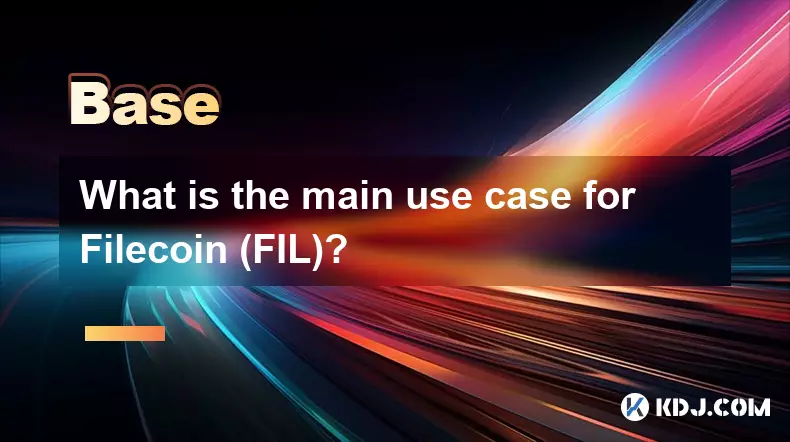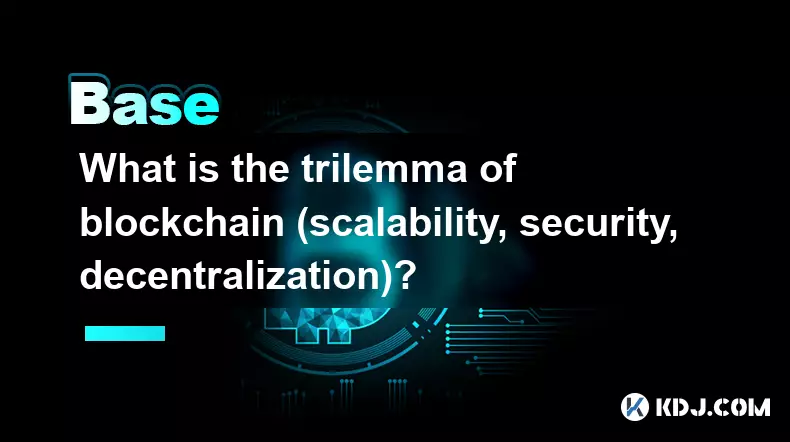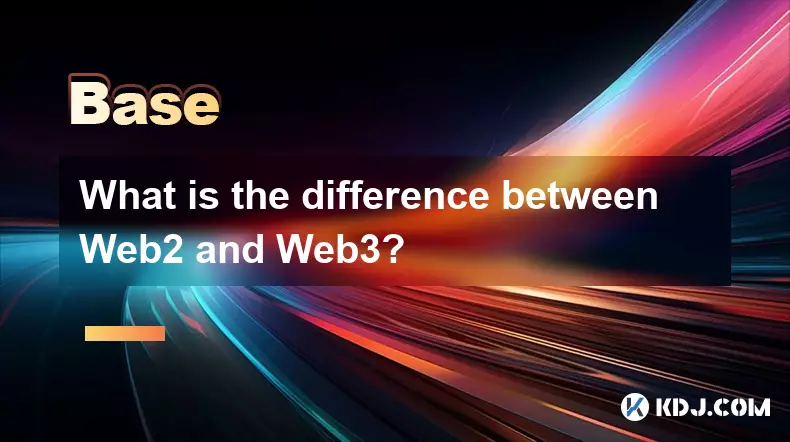-
 bitcoin
bitcoin $110047.851143 USD
-1.37% -
 ethereum
ethereum $3727.617466 USD
-1.30% -
 tether
tether $1.000961 USD
-0.05% -
 bnb
bnb $1114.045467 USD
1.72% -
 xrp
xrp $2.343280 USD
0.14% -
 solana
solana $174.674876 USD
-5.85% -
 usd-coin
usd-coin $0.999999 USD
0.02% -
 tron
tron $0.311757 USD
-2.44% -
 dogecoin
dogecoin $0.183678 USD
-3.76% -
 cardano
cardano $0.627109 USD
-2.07% -
 ethena-usde
ethena-usde $1.000300 USD
0.15% -
 hyperliquid
hyperliquid $36.865760 USD
-2.74% -
 chainlink
chainlink $16.968918 USD
-1.48% -
 stellar
stellar $0.318159 USD
0.47% -
 bitcoin-cash
bitcoin-cash $500.637224 USD
-1.56%
What is the main use case for Filecoin (FIL)?
Filecoin enables decentralized, secure, and censorship-resistant data storage through a global network of miners, using FIL tokens to incentivize reliability and long-term preservation.
Oct 12, 2025 at 05:18 am

Main Use Case of Filecoin (FIL)
1. Filecoin is primarily designed to create a decentralized storage network where users can store data securely and efficiently across a global network of computers. Instead of relying on centralized cloud providers like Amazon or Google, individuals and organizations rent out unused hard drive space to earn FIL tokens, while others pay in FIL to store their files. This peer-to-peer model disrupts traditional data storage by introducing competition, lower costs, and increased redundancy.
2. The network ensures data integrity through cryptographic proofs. Storage providers must continuously prove they are storing the data correctly using Proof-of-Replication and Proof-of-Spacetime. These mechanisms prevent fraud and guarantee that files remain accessible and unaltered over time. This trustless verification system is critical for maintaining reliability without a central authority.
3. Developers build applications on top of Filecoin for use cases such as archival storage, NFT metadata hosting, and content distribution. Because the data is distributed and resilient, it's ideal for preserving historical records, scientific datasets, or media assets that need long-term availability. Projects in the Web3 ecosystem often integrate Filecoin to ensure their digital assets aren’t dependent on fragile centralized servers.
4. Interoperability with IPFS (InterPlanetary File System) enhances Filecoin’s utility. While IPFS enables content addressing and fast retrieval, it doesn’t guarantee persistence. Filecoin complements IPFS by offering economic incentives for long-term storage, ensuring files pinned on IPFS don’t disappear when nodes go offline. This synergy strengthens the foundation of a permanent web.
Data Preservation and Censorship Resistance
1. One of the core benefits of Filecoin is its ability to preserve data across geographically dispersed nodes. When a file is stored, it’s broken into pieces, encrypted, and replicated across multiple independent storage providers. This redundancy protects against hardware failure, natural disasters, or malicious attacks targeting single points of failure.
2. Since no single entity controls the network, governments or corporations cannot easily censor or remove information. This makes Filecoin attractive for journalists, activists, and organizations operating in restrictive environments. Sensitive documents, open-source codebases, or public interest data can be archived without fear of arbitrary takedown requests.
3. Institutions like libraries, universities, and blockchain projects use Filecoin to back up critical information. For example, the Internet Archive has explored using Filecoin to store millions of books, videos, and websites, ensuring cultural heritage remains accessible even if primary sources vanish.
4. The permissionless nature of the network allows anyone to participate as a storage provider or user. This inclusivity fosters innovation and resilience, especially in regions underserved by conventional cloud infrastructure. Users retain full control over encryption keys, meaning only authorized parties can access the contents of stored files.
Economic Incentives and Token Utility
1. The FIL token serves as the native currency for transactions within the ecosystem. Clients pay FIL to storage miners for hosting data, and miners earn FIL rewards for providing reliable service. This creates a self-sustaining market where supply and demand determine pricing dynamically.
2. Miners must also lock up FIL as collateral to demonstrate commitment to honest behavior. If they fail to submit required proofs or lose data, they face penalties through slashing mechanisms. This aligns incentives between providers and users, promoting accountability and high uptime.
The staking and penalty system reinforces network security by making dishonest actions economically unviable.3. FIL holders can participate in governance as the protocol evolves. Upgrades, fee structures, and parameter adjustments may involve community input, giving stakeholders influence over the platform’s direction. This decentralization extends beyond infrastructure to decision-making processes.
4. Secondary markets have emerged around FIL, including lending platforms and derivatives trading. However, the primary focus remains on supporting real storage activity rather than speculative use. Protocol Labs, the team behind Filecoin, emphasizes utility-driven adoption to sustain long-term value.
Integration with Decentralized Applications
1. Many dApps leverage Filecoin for backend storage needs, particularly those involving large files or immutable records. For instance, video streaming platforms built on blockchain can store raw footage on Filecoin while referencing it via smart contracts on Ethereum or Polygon.
2. NFT creators increasingly rely on Filecoin to host artwork, music, and metadata off-chain. Storing these assets directly on blockchains is prohibitively expensive and inefficient. By anchoring NFTs to Filecoin-stored content, owners ensure permanence and reduce dependency on centralized gateways like AWS.
3. Decentralized social networks utilize Filecoin to store user-generated content such as posts, images, and messages. This prevents platform operators from unilaterally deleting accounts or censoring discussions. Users maintain ownership of their digital footprint.
4. Smart contract platforms integrate Filecoin through oracles or middleware layers. Contracts can trigger storage deals automatically based on predefined conditions, enabling autonomous workflows for data archiving, compliance logging, or audit trail creation.
Frequently Asked Questions
How does Filecoin differ from traditional cloud storage?Filecoin eliminates reliance on corporate data centers by distributing storage across a global network of independent operators. Pricing is determined by market dynamics rather than monopolistic providers, and data integrity is enforced through cryptographic proofs instead of trust in a single company.
Can I retrieve my data quickly from Filecoin?Retrieval speed depends on the number of replicas, geographic distribution of miners, and bandwidth availability. While not optimized for real-time streaming like CDN services, performance improves as the network grows and retrieval markets become more competitive.
Is my data private when stored on Filecoin?Data privacy relies on client-side encryption. Users must encrypt files before uploading since storage providers technically have access to raw data blocks. Proper key management ensures only intended recipients can decrypt and view the content.
What happens if a storage miner goes offline?The network detects missing proofs during periodic audits. Miners who fail to respond lose their collateral and are penalized. Meanwhile, redundant copies stored elsewhere allow clients to recover data seamlessly without interruption.
Disclaimer:info@kdj.com
The information provided is not trading advice. kdj.com does not assume any responsibility for any investments made based on the information provided in this article. Cryptocurrencies are highly volatile and it is highly recommended that you invest with caution after thorough research!
If you believe that the content used on this website infringes your copyright, please contact us immediately (info@kdj.com) and we will delete it promptly.
- XRP Price Prediction: Weekend Rollercoaster or Rally?
- 2025-10-12 08:45:16
- Bittensor (TAO): Super Bullish Signals Point to Potential 2x Rally
- 2025-10-11 10:25:12
- Silver Price Correction: Navigating the Dip & Identifying Key SEO Keywords
- 2025-10-11 10:25:12
- Decoding Crypto Trends: Bittensor's Bull Run, Cardano's Dip, and LivLive's Presale Buzz in 'Uptober 2025'
- 2025-10-12 08:45:16
- MoonBull: The Crypto Meme Coin Promising 1000x Gains?
- 2025-10-11 10:30:01
- Crypto Payroll Revolution: Stablecoins, Altcoins, and the Future of Salary Payments
- 2025-10-11 10:30:01
Related knowledge

What does it mean for code to be "open source" in crypto?
Oct 12,2025 at 01:54pm
Understanding Open Source in the Cryptocurrency Ecosystem1. In the context of cryptocurrency, open source refers to software whose code is publicly ac...

What is the purpose of a "testnet"?
Oct 12,2025 at 09:01am
Understanding the Role of Testnets in Blockchain Development1. A testnet serves as a parallel version of a blockchain network, designed specifically f...

What is the difference between single-collateral and multi-collateral Dai?
Oct 12,2025 at 05:18pm
Understanding Single-Collateral Dai1. Single-Collateral Dai (SCD) was the original version of the Dai stablecoin launched by MakerDAO in 2017. It allo...

What is "EIP-1559" and how did it change Ethereum?
Oct 12,2025 at 03:00am
Understanding EIP-1559 and Its Core Mechanism1. EIP-1559 is a protocol upgrade introduced to the Ethereum blockchain as part of the London hard fork i...

What is the trilemma of blockchain (scalability, security, decentralization)?
Oct 11,2025 at 10:36am
Understanding the Blockchain TrilemmaThe blockchain trilemma is a concept that highlights the inherent challenge in simultaneously achieving three cor...

What is the difference between Web2 and Web3?
Oct 11,2025 at 03:19pm
Understanding the Structural Shift from Web2 to Web31. Web2 is characterized by centralized platforms where large corporations control user data, cont...

What does it mean for code to be "open source" in crypto?
Oct 12,2025 at 01:54pm
Understanding Open Source in the Cryptocurrency Ecosystem1. In the context of cryptocurrency, open source refers to software whose code is publicly ac...

What is the purpose of a "testnet"?
Oct 12,2025 at 09:01am
Understanding the Role of Testnets in Blockchain Development1. A testnet serves as a parallel version of a blockchain network, designed specifically f...

What is the difference between single-collateral and multi-collateral Dai?
Oct 12,2025 at 05:18pm
Understanding Single-Collateral Dai1. Single-Collateral Dai (SCD) was the original version of the Dai stablecoin launched by MakerDAO in 2017. It allo...

What is "EIP-1559" and how did it change Ethereum?
Oct 12,2025 at 03:00am
Understanding EIP-1559 and Its Core Mechanism1. EIP-1559 is a protocol upgrade introduced to the Ethereum blockchain as part of the London hard fork i...

What is the trilemma of blockchain (scalability, security, decentralization)?
Oct 11,2025 at 10:36am
Understanding the Blockchain TrilemmaThe blockchain trilemma is a concept that highlights the inherent challenge in simultaneously achieving three cor...

What is the difference between Web2 and Web3?
Oct 11,2025 at 03:19pm
Understanding the Structural Shift from Web2 to Web31. Web2 is characterized by centralized platforms where large corporations control user data, cont...
See all articles










































































